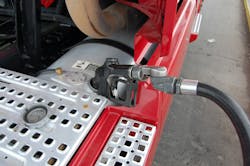Tropical Storm Isaac – which is expected to become a Category 1 hurricane before it makes landfall along the Gulf Coast today – will likely boost diesel and gasoline prices, largely due to the widespread shut-down of oil and natural gas facilities in the path of the storm.
In its most recent update, the Bureau of Safety and Environmental Enforcement (BSEE) estimates that approximately 78.02% of the current daily oil production in the Gulf of Mexico is now shut down, along with approximately 48.13% of the current daily natural gas production in the same area.
The agency said personnel from 346 production platforms have been evacuated ahead of the storm, equivalent to 58.05% of the 596 manned platforms in the Gulf of Mexico, along with all staff manning 41 rigs, equivalent to 53.9% of the 76 rigs currently operating in the Gulf.
BSEE noted that production platforms are static structures located offshore from which oil and natural gas are produced, while drilling rigs are more mobile and include several types including jack-up rigs, submersibles and semi-submersibles.
AAA noted that Isaac already pushed gasoline prices up some 2 cents per gallon on average in the U.S. over the weekend and expects a similar price spike to occur once the storm moves through the Gulf region.
According to the Energy Information Administration (EIA), diesel increased 6.3 cents this week to reach an average of $4.089 per gallon across the U.S.; some 26.9 cents higher per gallon compared to the same period in 2011.
Diesel pump prices are up in every region of the U.S., the agency noted, with California the highest at $4.409 per gallon, followed by the West Coast ($4.288), the Rocky Mountain region ($4.149), New England ($4.132) and the Central Atlantic area ($4.129).
Ironically, the Gulf Coast is the only region of the country where diesel remains below the $4 per gallon mark, though just barely, at $3.981 per gallon, EIA reported.
However, Tom Kloza, a senior oil analyst for Oil Price Information Service (OPIS), warned during a recent Fleet Owner webinar that – based on the data he examines – diesel could be poised for a significant price “run-up” following a short drop over the Labor Day holiday weekend.
By contrast, EIA reported that gasoline prices increased much more slowly in the U.S. over the past week – rising 3.2 cents to reach $3.776 per gallon on average across the country, which is 14.9 cents higher per gallon compared to the same time period in 2011.
Again, all regions of the U.S. reported higher gasoline prices, with the West Coast at the top with gasoline costing $4.04 per gallon, followed by New England ($3.818), the Central Atlantic area ($3.781) and the Midwest ($3.778).
That being said, though, AAA continues to expect that prices at the pump will decline following the Labor Day holiday as the traditional "summer driving season" draws to a close and the switch over from summer- to winter-blend gasoline begins to take place. That forecast, however, is tempered by whatever damage is caused by Isaac, the group stressed.
AAA also noted that while the national price at the pump has risen 20 cents to date in August, it remains 22 cents below the yearly peak price for 2012 of $3.94 on April 5 and 6 and 39 cents below the all-time high set in 2008.
As the group noted in its monthly AAA Fuel Gauge Report, while the national average for gasoline has risen steadily since late July, the steady increase has obscured the regional price spikes that have characterized the August increase.
While the national average price is 14 cents higher than a year ago, the year-over-year increase is most dramatic in the Midwest and on the West Coast, where prices have been impacted by regional supply and distribution issues, the group said.
For example, AAA pointed to the supply issues during the first week of August for the Midwest, primarily due to issues with Enbridge pipeline in Wisconsin, followed by a fire at the Chevron refinery in Richmond, CA, on August 6 sent West Coast prices sharply higher and continued to tug the national average upward.
About the Author
Sean Kilcarr
Editor in Chief
Sean Kilcarr is a former longtime FleetOwner senior editor who wrote for the publication from 2000 to 2018. He served as editor-in-chief from 2017 to 2018.
